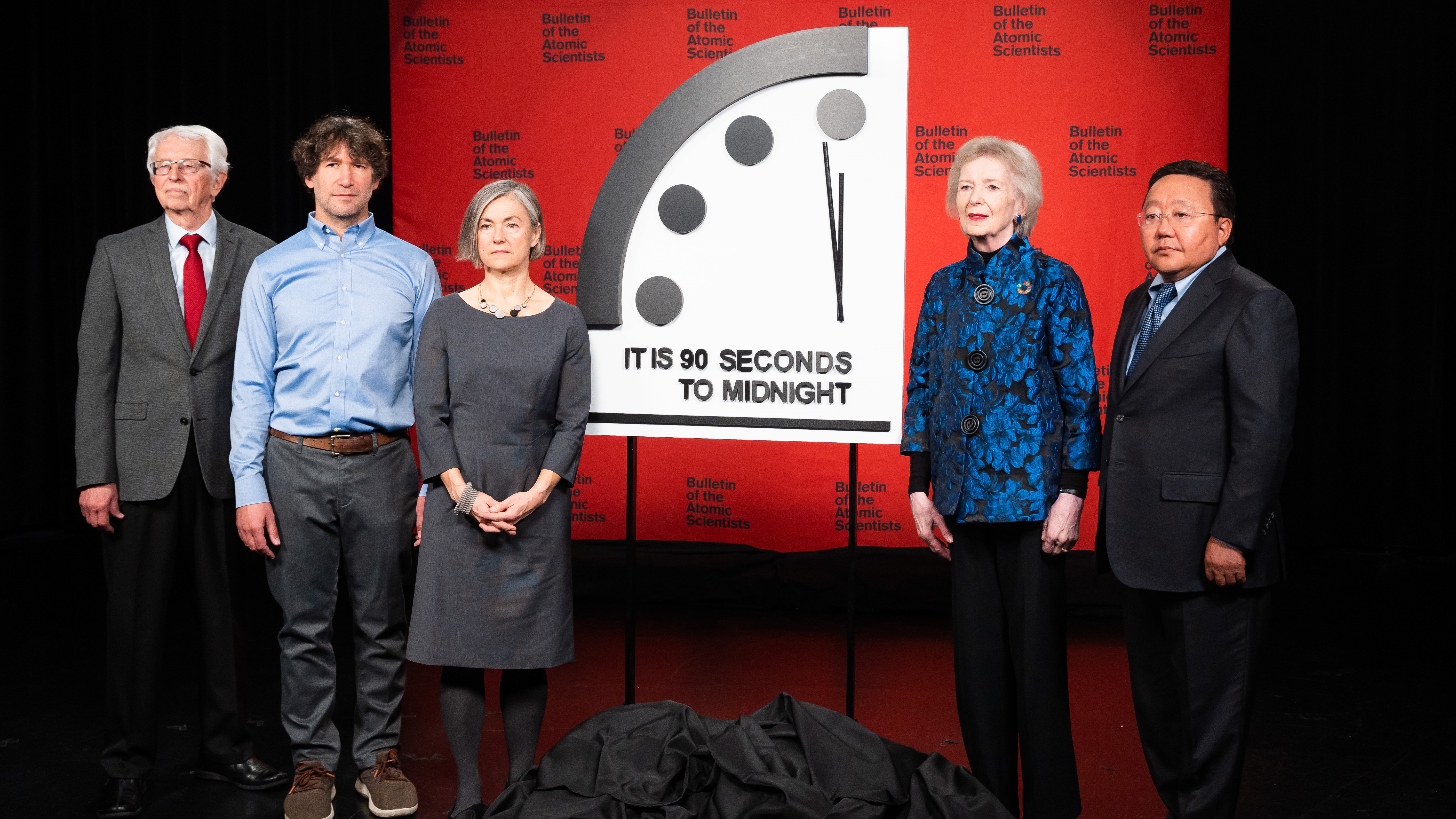Nuclear Risk Rising
With the Doomsday clock set to 90 seconds to midnight, and Russia suspending participation in a key nuclear arms control treaty, the risk of nuclear war is higher than ever.
With the Doomsday clock set to 90 seconds to midnight, and Russia suspending participation in a key nuclear arms control treaty, the risk of nuclear war is higher than ever. The following article was published in the March-April 2023 issue of NewsNotes.
The risk of global nuclear disaster is escalating. On January 24, the Bulletin of the Atomic Scientists moved the hands of the Doomsday Clock to 90 seconds to midnight – closer to global catastrophe than at any time in the symbolic clock’s 76-year history. The Bulletin’s Science and Security Board statement on the change attributed it largely to destabilization and nuclear threats stemming from Russia’s war on Ukraine and the weakening of the multilateral infrastructure that has historically mitigated such threats.
As if to confirm the board’s assessment, President Vladimir Putin announced on February 21, three days before the first anniversary of the Ukraine war, that Russia was officially suspending its participation in New START, the last remaining nuclear arms control treaty between the United States and Russia. Russian began refusing inspections of nuclear sites mandated by the treaty last year, citing the U.S. policy of inflicting “strategic defeat on Russia” through its support for Ukraine.
The Doomsday Clock statement calls on the United States, together with NATO allies and Ukraine, to pursue dialogue with Moscow aimed at nuclear risk reduction and peace negotiations.
“As Russia’s war on Ukraine continues,” the board writes, “the last remaining nuclear weapons treaty between Russia and the United States, New START, stands in jeopardy. Unless the two parties resume negotiations and find a basis for further reductions, the treaty will expire in February 2026. This would eliminate mutual inspections, deepen mistrust, spur a nuclear arms race, and heighten the possibility of a nuclear exchange.”
While the report focuses mainly on Ukraine, other global developments highlight the dire need for nuclear arms control and disarmament. East Asia is of note in recent weeks. On January 11th South Korea announced for the first time that it may pursue its own nuclear weapons, or request the redeployment of U.S. nuclear weapons to the peninsula 32 years after their removal, if North Korean threats continue to escalate. Rather than prioritizing peace between the two Koreas, the US responded by sending more conventional weapons to the peninsula, and assuring South Korea of U.S. nuclear protection – although studies suggest such support may only further stoke the fears of South Koreans. Meanwhile, tensions between the United States and nuclear-armed China continue to escalate. And in a historic move, Japan has announced its largest military build-up since World War II. Elsewhere, talks between the United States and Iran aimed at salvaging the Iran nuclear deal have stalled, and tensions between Palestinians and nuclear-armed Israel have increased.
People of faith, particularly in countries with nuclear weapons, must call on leaders to pursue a robust program of negotiations and disarmament. Pope Francis has repeatedly condemned not only the use but the possession of nuclear weapons, even as deterrence. The Holy See was among the first states to ratify the UN Treaty for the Prohibition of Nuclear Weapons (TPNW). Pope Francis affirmed the promise of such efforts at a 2017 Vatican conference on nuclear disarmament, asserting “progress that is both effective and inclusive can achieve the utopia of a world free of deadly instruments of aggression, contrary to the criticism of those who consider idealistic any process of dismantling arsenals.”
Archbishop John Wester of Santa Fe, discussing his landmark 2022 pastoral letter, “Living in the Light of Christ’s Peace: A Conversation Toward Nuclear Disarmament,” has promoted the five policy proposals of the Back from the Brink campaign: 1) pursue the global elimination of nuclear weapons, 2) renounce the current U.S. “first use” policy, 3) end the sole authority of the president to launch a nuclear attack, 4) take the U.S. nuclear arsenal off of hair-trigger alert, and 5) cancel plans to replace the U.S. arsenal with enhanced nuclear weapons.
On January 31st, Rep. Jim McGovern introduced a resolution in the U.S. House of Representatives, H. Res. 77, “Embracing the goals and provisions of the Treaty on the Prohibition of Nuclear Weapons” and calling on the U.S. government to pursue the five policy proposals of the Back from the Brink campaign.
Faith in Action
Read more about the Back from the Brink campaign, and find out if your city, county or state has endorsed the campaign’s proposals at http://bit.ly/backbrink Then contact your Member of Congress and ask them to co-sponsor H.Res. 77 today at http://bit.ly/77action
Photo by Jamie Christiani of the Doomsday clock reveal courtesy of the Bulletin of the Atomic Scientists

